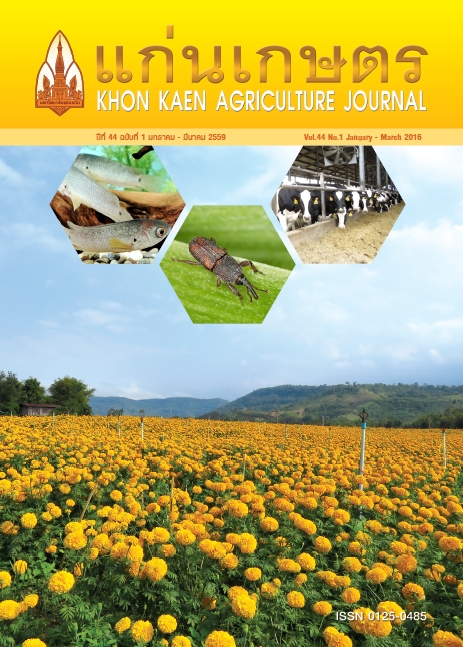การศึกษาประสิทธิภาพของสารสกัดหยาบบอระเพ็ดที่สกัดด้วยตัวทำละลายอินทรีย์ 3 ชนิดในการเป็นสารไล่และยับยั้งการกินอาหารต่อตัวเต็มวัยด้วงงวงข้าวโพด (Sitophilus zeamais Motschulsky)
Main Article Content
บทคัดย่อ
การศึกษาประสิทธิภาพของสารสกัดหยาบเฮกเซน, ไดคลอโรมีเทน และเมทานอลจากเถาบอระเพ็ดสดและแห้งในการเป็นสารไล่และสารยับยั้งการกินอาหารต่อตัวเต็มวัยด้วงงวงข้าวโพดโดยการทดสอบในจานทดสอบแบบให้ทางเลือกแก่แมลง พบว่า สารสกัดหยาบทั้ง 3 ชนิด ที่ความเข้มข้น 157.27, 471.81, 786.35, 1,100.89 และ 1,415.43 มคก./ตร.ซม. มีประสิทธิภาพในการเป็นสารไล่ด้วงงวงข้าวโพด โดยมีค่าเฉลี่ยการไล่มากกว่า 50% ในช่วงเวลา 1-5 ชั่วโมง หลังการทดลอง สารสกัดหยาบเมทานอลจากเถาบอระเพ็ดสดและแห้งมีประสิทธิภาพในการเป็นสารไล่ด้วงงวงข้าวโพดดีที่สุด มีค่าเฉลี่ยการไล่อยู่ในช่วง 67.2-75.6% และ 68.8-82.4% ตามลำดับ ที่ช่วงความเข้มข้นทดสอบ ตามมาด้วยสารสกัดหยาบไดคลอโรมีเทน และสารสกัดหยาบเฮกเซน สารสกัดหยาบเมทานอลจากเถาบอระเพ็ดสดและแห้งยังมีประสิทธิภาพในเป็นสารยับยั้งการกินอาหารของด้วงงวงข้าวโพดดีที่สุดเมื่อเทียบกับสารสกัดหยาบไดคลอโรมีเทนและเฮกเซน โดยมีค่าดัชนียับยั้งการกินอาหารเท่ากับ 97.33 และ 87.75% ที่ความเข้มข้นทดสอบสูงสุด (9%, w/v) สำหรับสารสกัดหยาบบอระเพ็ดสดและแห้ง ตามลำดับ เมื่อเวลาผ่านไป 2 วัน หลังการทดสอบ
Article Details
เอกสารอ้างอิง
บุญส่ง คงคาทิพย์. 2538. การแยกสารออกฤทธิ์ฆ่าหนอนเจาะสมอฝ้ายจากต้นบอระเพ็ดและการศึกษาความสัมพันธ์ระหว่างโครงสร้างของสารกับการออกฤทธิ์. รายงานผลการวิจัยประจำปี 2538. ภาควิชาเคมี, คณะวิทยาศาสตร์, มหาวิทยาลัยเกษตรศาสตร์.
Bell, C.H., and S.M. Wilson. 1995. Phosphine tolerance and resistance in Trogoderma granarium everts (Coleoptera: Dermestidae). J. Stored Prod. Res. 31: 199-205.
Cavin, A., K. Hostettmann, W. Dyatmyko, and O. Potterat. 1998. Antioxidant and lipophilic constituents of Tinospora crispa. Planta Med. 64: 393-396.
Darwish, Y.A., Y.M. Omar, R.E. Hassan, and M.A. Mahmoud. 2013. Repellent effects of certain plant essential oil, plant extracts and inorganic salts to granary weevil, Sitophilus granaries (L.). Arch. Phytopathology Plant Protect. 46: 1949-1957.
Dominguez, J., and L. Marrero. 2010. Catalogo de la entomofauna asociada a almacenes de alimentos enla provincial de Matanzas. Fitosanidad. 14: 75-82.
Emekci, M. 2010. Que vadis the fumigants?. P. 303-313. In: O.M. Carvalho, P.G., Fields, C.S. Adler, F.H. Arthur, C.G. Athanassiou, J.F. Campbell, F. Fleurat-Lessard, P.W. Flinn, R.J. Hodges, A.A. Isikber, S. Navarro, R.T. Noyes, J. Riudavets, K.K. Sinha, G.R. Thorpe, B.H. Timlick, P. Trematerra, and N.D.G. White (Eds.). Proceedings of The 10th International Working Conference on Stored Product Protection. Julius-Kuhn-Archiv, Estoril.
Hayashi, T., S. Nakamura, P. Visarathanonth, J. Uraichuen, R. Kengkanpanich. 2004. Stored rice insect pest and their natural enemies in Thailand. Japan International Research Centre for Agricultural Sciences, Bangkok. International Agricultural Series No.13.
Ishii, T., H. Matsuzawa, and C.S. Vairappan. 2010. Repellent activity of common spices against the rice weevil, Sitophilus zeamais Motsch (Coleoptera, Curculionidae). J. Trop. Biol. Conserv. 7: 75-80.
Kongkathip, N., P. Dhumma-upakorn, B. Kongkathip, K. Chawananoraset, P. Sangchomkaeo, and S. Hatthakitpanichakul. 2002. Study on cardiac contractility of cycloeucalenol and cycloeucalenone isolated from Tinospora crispa. J. Ethnopharm. 83: 95-99.
Mueller, D.K. 1990. Fumigantion, Handbook of Pest Control. Franzak and Foster Co., Cleveland, Ohio.
Othira, J.O., L.A. Onek, L.A. Deng, and E.O. Omolo. 2009. Insecticidal potency of Hyptis spicigera preparations against Sitophilus zeamais (l.) and Tribolium castaneum (herbst) on stored maize grains. Afr. J. Agric. Res. 4: 187-192.
Nor Aziyah, B., I. Norain, A.W. Nor Aimi, B.T. Lim, W.K. Wan Zarina, and F. Siti Nur Amirah Diana. 2014. Biopesticidal effect of Tinospora crispa extract against flea beetle, Phyliotera sinuate ateph. Res. J. Biotech. 9: 1-5.
Ragasa, C.Y., M.C. Cruz, R. Gula, and J.A. Rideout. 2000. Clerodane diterpenes from Tinospora rumphii. J. Nat. Prod. 63: 509-511.
Rees, D. 2004. Insects of Stored Products. CSIRO Publishing, Canaberra.Rejesus, B.M. 1987. Botanical pest control research in the Philippine. Philippine Entomol. 7: 1-30.
Viglianco, A.I., R.J. Novo, C.I. Cragnolini, M. Nassetta, and A. Cavallo. 2008. Antifeedant and repellent effects of extracts of three plants from Cordoba (Argentina) against Sitophilus oryzae (L.) (Coleoptera: Curculionidae). Bioassay. 3: 1-6.
Vinayachandra, S.R., and K.R. Chandrashekar. 2011. Larvicidal acticities of Knemaatte nuata (Hook. f. & Thomson) Warb. (Myristicaceae) extracts against Aedes albopictus Skuse and Anopheles stephensiListon. Parasitol. Res. 109: 1671-1676.
Subramanyam, B., and D.W. Hagstrum. 1995. Resistance measurement and management. P. 331-397. In: B. Subramanyam and D.W. Hagstrum (Eds.). Integrated Management of Insects in Stored Products. Marcel Dekker, New York.
Suprapta, D.N., I.W. Suanda, N. Arya, and K. Ohsawa. 2003. Insecticidal activity of Tinospora crispa leaf extract against Diamondback moth in cabbage. J. IssAAS. 9: 18-24.
Wei, L., R. Hua, M. Li, Y. Huang, S. Li, Y. He, and Z. Shen. 2014. Chemical composition and biological activity of star anise Illicium verum extracts against maize weevil, Sitophilus zeamais adults. J. Insect Sci. 14: 1-13.
Wink, M. 1993. Production and application of phytochemicals from an agricultural perspective. P. 171-213. In: T.A. van Beek and H. Breteler (Eds.). Phytochemistry and Agriculture, Vol.34. Clarendon, Oxford.
Yao, Y., W. Cai, C. Yang, D. Xue, and Y. Huang. 2008. Isolation and characterization of insecticidal activity of (Z)-asarone from Acorus calamus L. Insect Sci. 15: 229-236.


